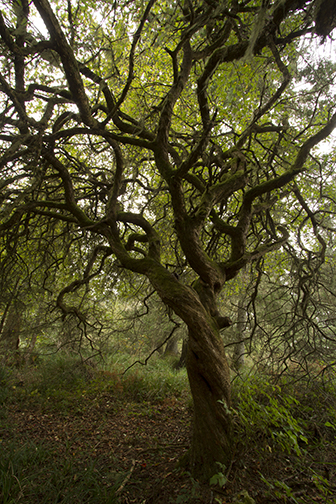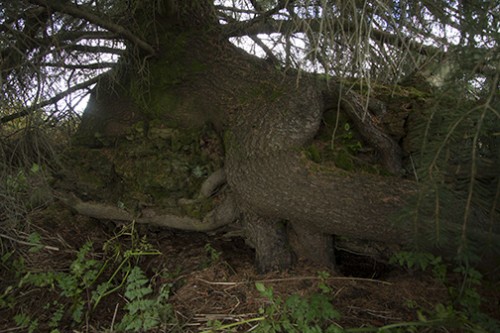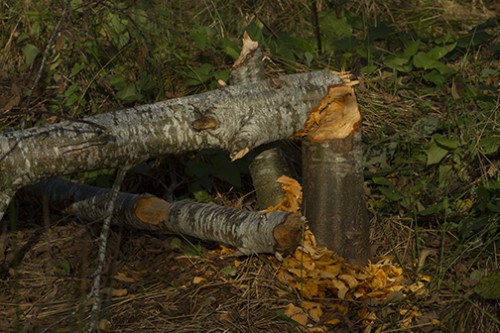When Gearhart nature photographer Neal Maine looks at a tree, what he sees isn’t just a static object but a story—an adventure story, one full of unexpected plot twists and plenty of character development. Take this crabapple tree growing in NCLC’s Neacoxie Forest Habitat Reserve, for example. “It could be just a pretty picture,” he says, “but trees are products of their life histories. They have all these capacities for change and adaptation. So when you look at a tree like this, you’re saying, ‘Thank you, wind, thank you, shade’—all these forces that made the tree like that.” Natural forces such as these function like a mold in which the tree grows—a mold consisting of, in this case, “the weather, a big spruce growing and blocking the sun from one part of the crabapple tree but not another, maybe a squirrel gnawing on the apples, and moss, and insects …
“I’ve been trying to photograph that tree for 10 years. I haven’t got it yet, but I keep going back at it.”
“Imagine how many millions of pounds of pressure there are on the roots of that tree,” Neal says of this Sitka spruce growing—still growing, horizontally—maybe 50 yards downstream of the crabapple. “It’s not defying gravity, but it looks like it is. Spruce live on the Oregon Coast. They don’t worry about the wind, they adjust to it. This one blew over and just kept on trucking.”
You can’t talk about the adventures of trees on Oregon’s north coast without talking about beavers—at least Neal can’t. These alders were active participants in the ecosystem while alive, growing across the street from the wetlands at Thompson Creek, and they still are, providing food and building material for beavers, our partners in salmon conservation.
Neal calls the photo above “Take Your Nurse Log With You.” The gale of December 2007 blew over a couple of conifers and an alder growing on the same nurse log a few steps from the trail at Circle Creek; when they went down, they exposed the nurse log they were growing on. Those trees died (the alder’s branches appear ghostly white in this photo), but a whole new community of trees and shrubs is now growing on those trees’ roots, still attached to their rearranged nurse log.
Neal has been following the adventures of this particular spruce, growing in the middle of the marsh north of the Avenue S bridge in Seaside, for some 15 years. When he first noticed it, it was a seedling growing on a drift log floating in the Mill Ponds, upstream of the bridge. It moved from place to place as its host log was pushed around by winter’s high waters. Finally, when the tree was about 8 feet tall, that log got mired on slightly higher ground below the bridge, allowing the spruce’s roots to dig in. “There could have been 50 seedling trees growing on that drift log, but this one is the survivor,” Neal says. Today that tree is nearly 40 feet tall. Meanwhile its nurse log is starting to decay away, having done its job; the photo below is a close-up of its roots.
“In estuaries, if you look around, most of the spruce trees you see started on drift logs, because they seldom get started in soil; they have to grow on something,” Neal says. “This tree is a survivor. It finally found a home base, and it’s probably destined to thrive there, up out of the tidewater. I think it’s all going to work out.”
Oops: there went another alder, even before Neal got around to downloading that earlier beaver-downed alder photo.
Meanwhile, back at Circle Creek—about 50 yards north of the trail, along the same creek that runs under the trail’s footbridges—is this testament to the dedication of one tree’s root system to helping that tree thrive and shoot up into the sky. Those roots were shaped by the effort to climb down and around the end of the nurse log—Neal thinks it may have been a sawn log—and anchor themselves in the soil; so great was that effort that at least one root is now larger than the tree’s trunk. The nurse log has since decayed away, leaving this tree standing on very capable stilts.
This Sitka spruce is a sister to the tree shown above it, having grown on the other end of the same nurse log. It’s no youngster; it may not be many years until it takes its own turn nurturing the forest’s next generation. “Spruce: they got it,” Neal says. “They know what they’re doing.”
It’s not hard to see trees as stories, Neal says. “You just have to get tuned into in a different way of seeing than you might normally walk around with in a forest.”









Comments